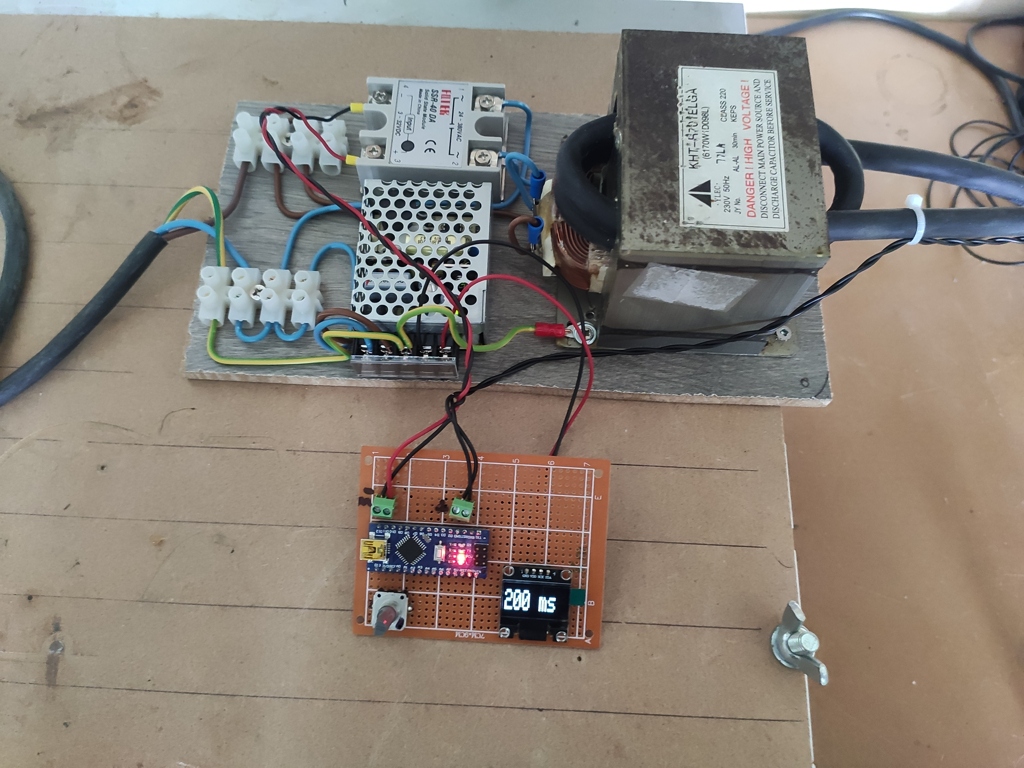Hi,
I have built a microvawe transformer spotwelder, I have put a single turn of welder wire for in the secondary and I’m timing it with arduino. Worth mentioning it was/is a 230V transformer. Electrodes are sharpened copper rods. I believe the voltage is still high. The spotwelds it produces are slightly discolored and not as strong as you would expect. Is this design fundamentally borked? Is there anything else I can make to make it better?
Photo from test stage before it was built into a project box, it is less “shocking” now.

Microvawe?
What is your question exactly?
Just in case you really didn’t understand: it’s wave, not vawe. It’s a common spelling mistake, especially for people whose native language doesn’t have the w letter.
See radio wave.
Spell check
I believe the voltage is still high
I believe there are devices that can measure such things
I did measure, voltage is 3v rms
I don’t have any improvements to offer but I want to mention that I saw a crazy video that used a circuit breaker as a spot welding device. The concept is pretty much right and it is as cheap as it can gets, but it is electroboom kind of crazy and the guy even hurt himself on camera while using it.
Where is the video? Electroboom craziness sounds entertaining.
https://www.youtube.com/watch?v=K_pD0W_Fm6g
He burnt himself off a 12v battery. Increase the voltage by the amount you want to live dangerously at the benefit of getting better weld. It also suggests using two MCBs in series in case one of them does not trip for any reason.
If it’s a 240v transformer, the primary will have less turns than a 120v one. You may not have a high enough voltage out of your new secondary because of that.
Would trimming down the voltage on the primary with a triac would help?
You need to go up in voltage, not down.
Try it on 240v. (check your 5v supply can handle that, or power it separately)
I have 230V or 400V three phase. I live in the EU. So this cannot be solved without replacing the winding on the transformer I guess.
If you have a 230V supply and a 230V transformer, you are fine. I believe they thought you were using a 120V supply on a 230V transformer.
Raising the input voltage will probably not get you what you want.
If it’s just a matter of getting a larger voltage, then you already got 400V. No need for new windings, unless the insulation on the primary can’t handle 400V.
I need lower voltage. 1-2V on the secondary. I have 3V rms now.
Are you able to measure the input current during a weld?
I suspect you might not have enough copper in the secondary. Fully insulated wires take up a lot of space; there’s a reason magnet wire is commonly used. Several parallel turns of e.g. 6mm^2 magnet wire would be preferable.
Your SSR generally should be in the phase, not the neutral.
Yeah, just gonna chime in here real quick.
I went down this road just as you. I found out that most MOTs are rather weak for 18650 nickel strips.
You need a transformer rated around 1500 watts. Most are 700-900 watts. I ended up wiring 2 transformers in parallel. Also, make sure to remove the transformer’s shunts. They are a form of current limiting and will impact your amps at the end.
Finally, make sure to carefully regulate your pressure with the copper tips. High pressure does indeed equal a weaker weld.
AC in general is also not the best for very short pulses of welds. I have found that 40-60ms work best for 0.2 with around 1000amps. Anything less didn’t weld tbh and the MOT couldn’t pull amps fast enough. I tried all sorts of windings and cable thicknesses. I finally chose 6AWG and I’m happy enough with 2 transformers.


